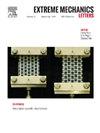Characterization of 3D printed micro-blades for cutting tissue-embedding material
IF 4.5
3区 工程技术
Q2 MATERIALS SCIENCE, MULTIDISCIPLINARY
引用次数: 0
Abstract
Cutting soft materials on the microscale has emerging applications in single-cell studies, tissue microdissection for organoid culture, drug screens, and other analyses. However, the cutting process is complex and remains incompletely understood. Furthermore, precise control over blade geometries, such as the blade tip radius, has been difficult to achieve. In this work, we use the Nanoscribe 3D printer to precisely fabricate micro-blades (i.e., blades <1 mm in length) and blade grid geometries. This fabrication method enables a systematic study of the effect of blade geometry on the indentation cutting of paraffin wax, a common tissue-embedding material. First, we print straight micro-blades with tip radius ranging from ∼100 nm to 10 μm. The micro-blades are mounted in a custom nanoindentation setup to measure the cutting energy during indentation cutting of paraffin. Cutting energy, measured as the difference in dissipated energy between the first and second loading cycles, decreases as blade tip radius decreases, until ∼357 nm when the cutting energy plateaus despite further decrease in tip radius. Second, we expand our method to blades printed in unconventional configurations, including parallel blade structures and blades arranged in a square grid. Under the conditions tested, the cutting energy scales approximately linearly with the total length of the blades comprising the blade structure. The experimental platform described can be extended to investigate other blade geometries and guide the design of microscale cutting of soft materials.
用于组织包埋材料切割的3D打印微刀片的特性研究。
在微尺度上切割软材料在单细胞研究、类器官培养的组织显微解剖、药物筛选和其他分析中有了新的应用。然而,切割过程是复杂的,仍然不完全了解。此外,对叶片几何形状的精确控制,如叶片尖端半径,一直难以实现。在这项工作中,我们使用Nanoscribe 3D打印机精确制造微叶片(即叶片)
本文章由计算机程序翻译,如有差异,请以英文原文为准。
求助全文
约1分钟内获得全文
求助全文
来源期刊

Extreme Mechanics Letters
Engineering-Mechanics of Materials
CiteScore
9.20
自引率
4.30%
发文量
179
审稿时长
45 days
期刊介绍:
Extreme Mechanics Letters (EML) enables rapid communication of research that highlights the role of mechanics in multi-disciplinary areas across materials science, physics, chemistry, biology, medicine and engineering. Emphasis is on the impact, depth and originality of new concepts, methods and observations at the forefront of applied sciences.
 求助内容:
求助内容: 应助结果提醒方式:
应助结果提醒方式:


